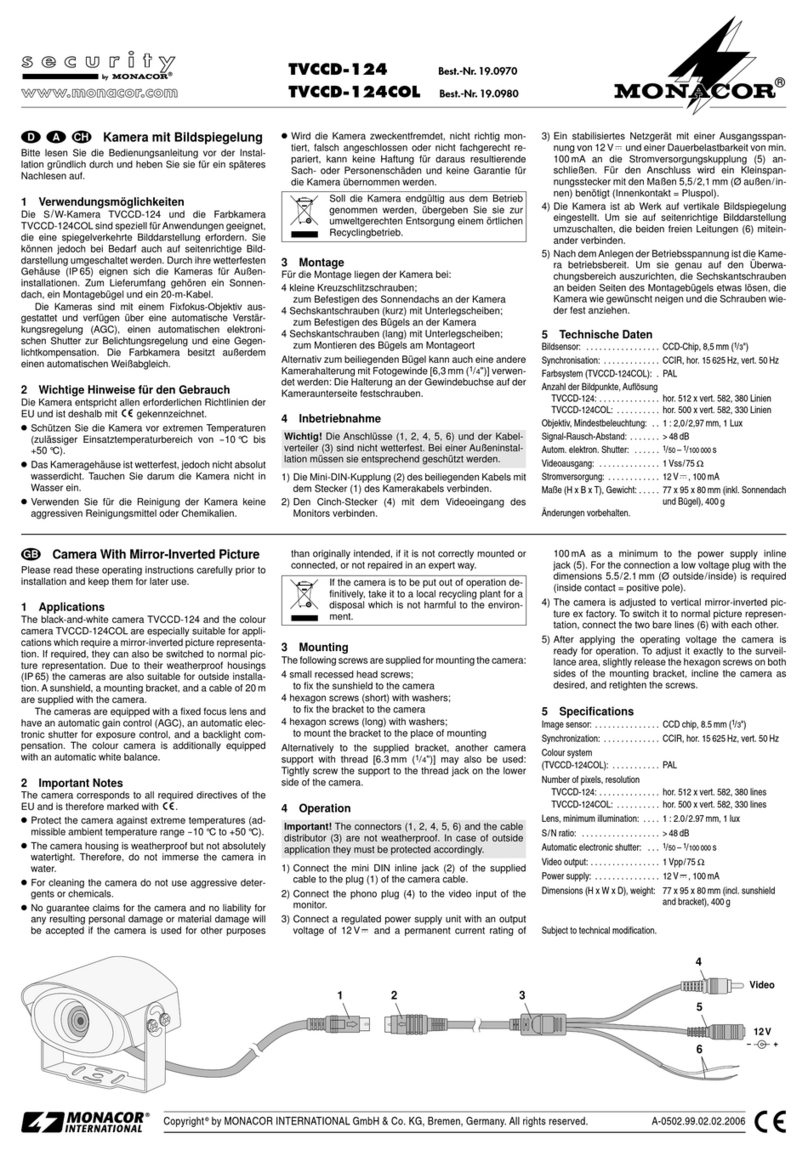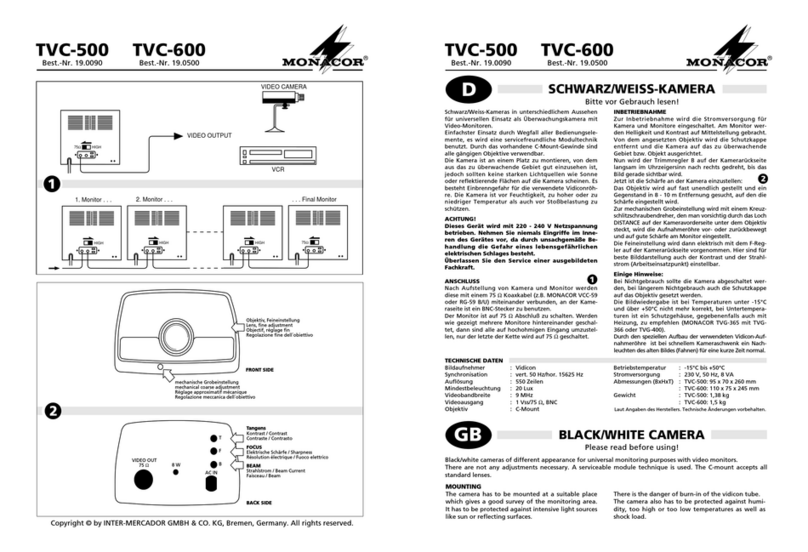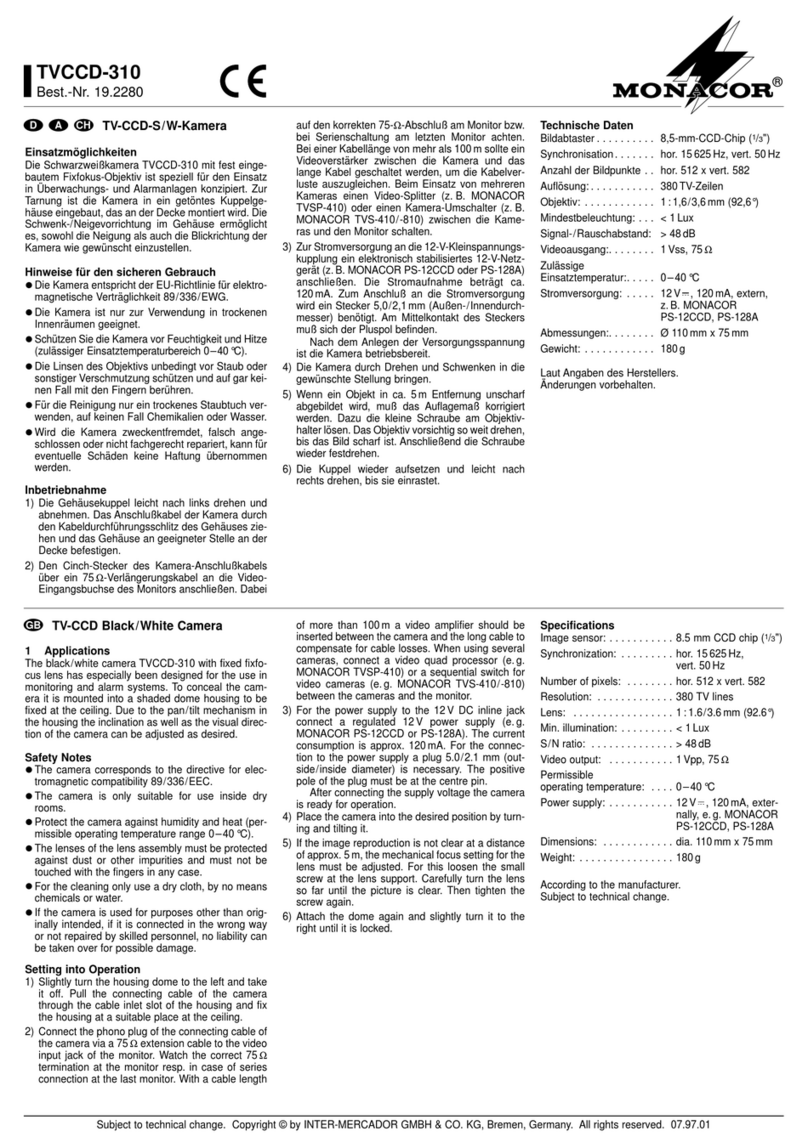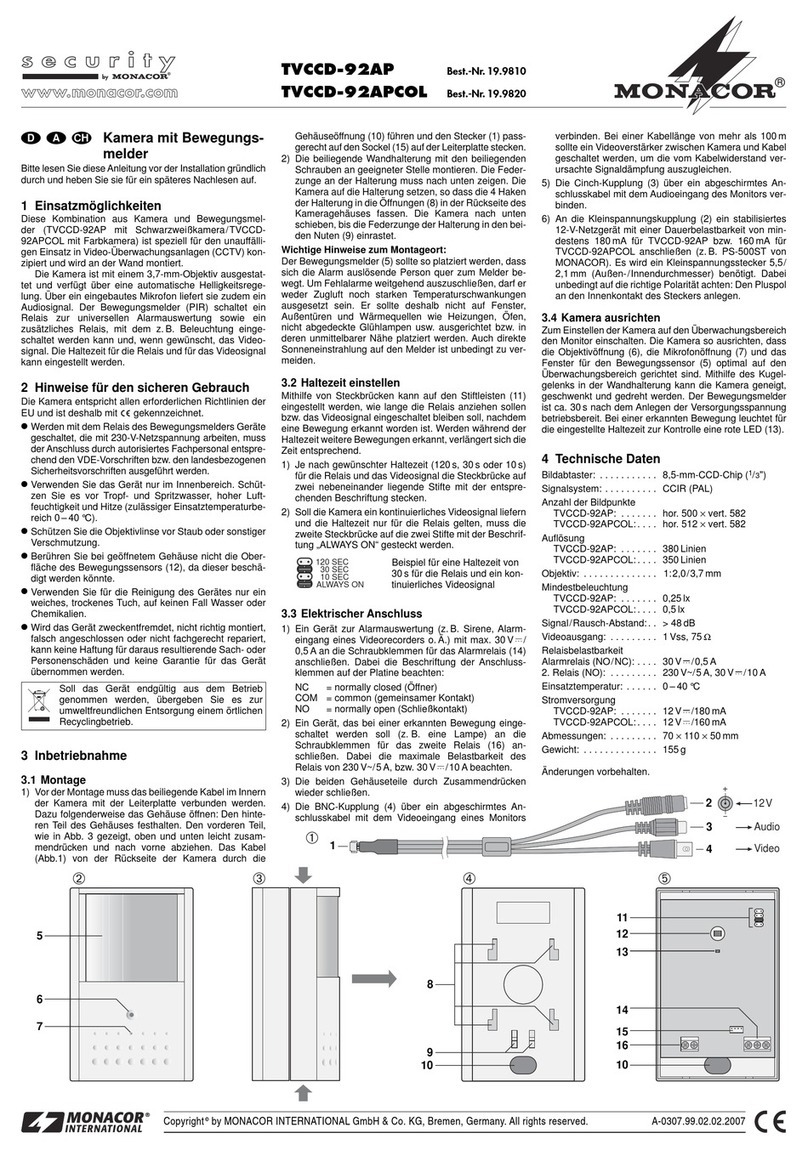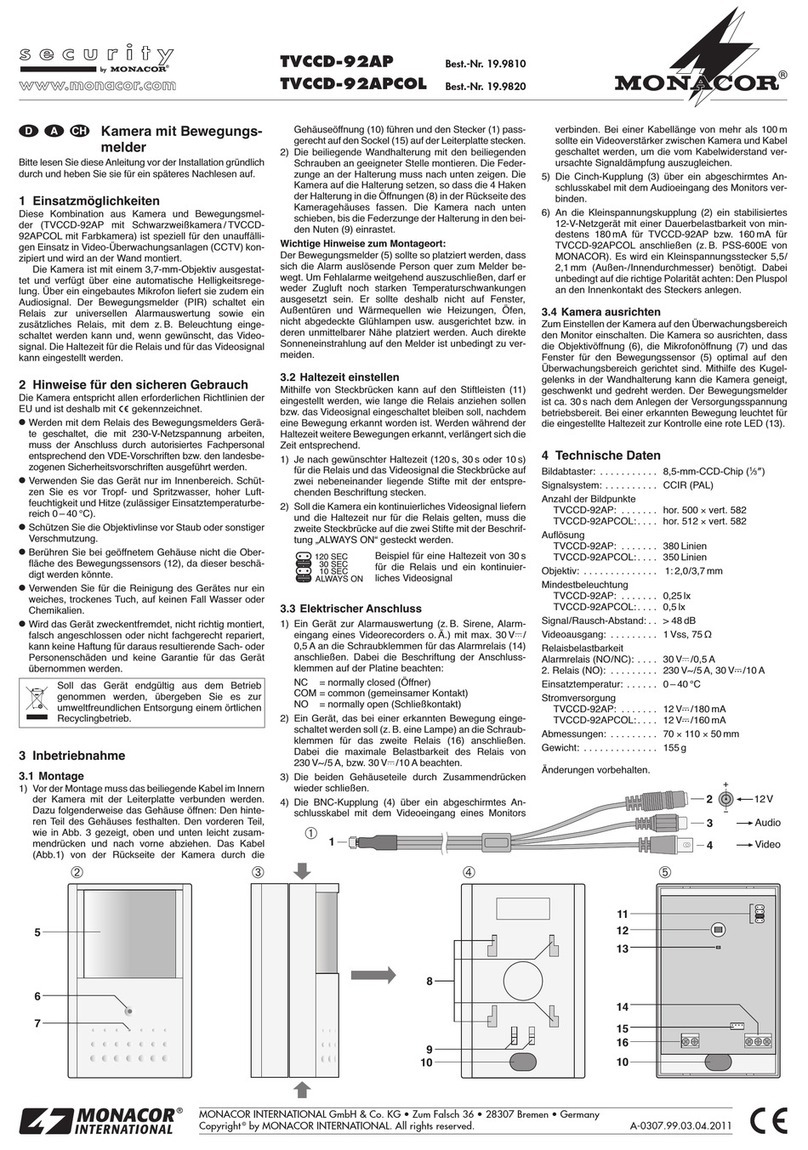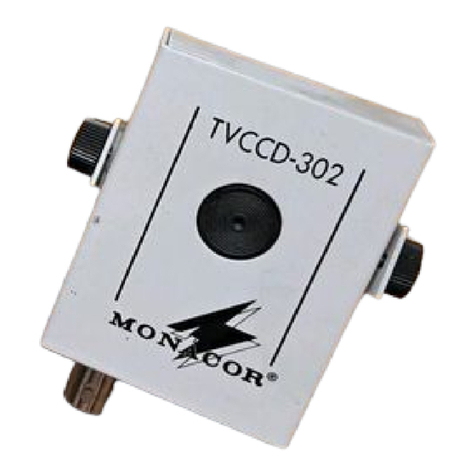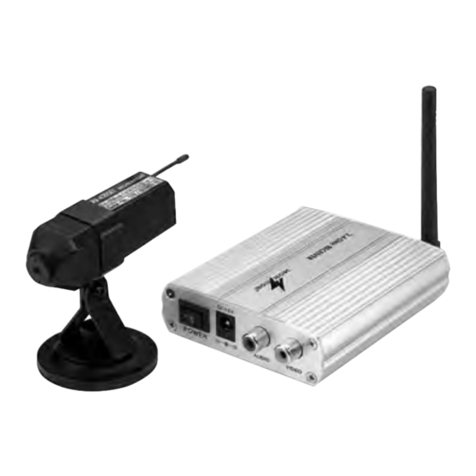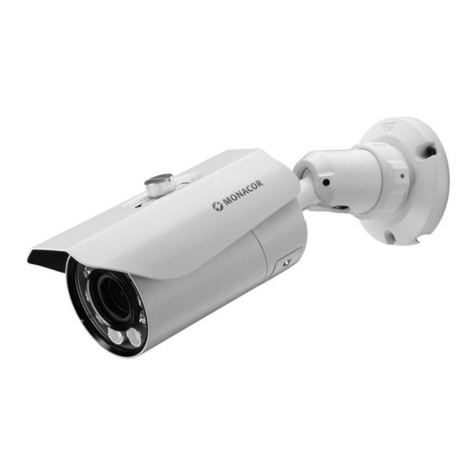Cámara en blanco y negro espía de
puerta
Por favor, lea atentamente estas instrucciones antes
de la instalación y consérvelas para usos posteriores.
1 Posibilidades de utilización
La cámara en blanco y negro con un objetivo extra
grande ángulo está fabricada para una utilización
como espía de puerta en instalaciones de vídeo vigi-
lancia (CCTV). Puede colocarse en puertas de un
espesor de 42 mm a 66 mm. La cámara dispone de
una obturación electrónica automática y de una regu-
lación automática de amplificación (AGC).
2 Consejos de seguridad y utilización
La cámara corresponde a todas las directivas rele-
vantes por la UE y por ello está marcada con .
GProteja la cámara de las salpicaduras, de todo tipo
de proyecciones de agua, una humedad elevada y
de las temperaturas extremas (temperatura de
ambiente admisible 0 – 40 °C).
GNo toque nunca con los dedos las lentes del objeti-
vo, y para limpiarlas utilice solamente productos
específicos para las lentes ópticas.
GDeclinamos toda responsabilidad en caso de daños
corporales o materiales resultantes de la utilización
de la cámara con otro fin del que le es propio, si no
está montada, conectada correctamente o repara-
da por una persona habilitada, además, carecería
de todo tipo de garantía.
3 Funcionamiento
1) Haga un agujero de 21 mm de diámetro en la puer-
ta. Además, corte una muesca para pasar el cable.
2) Monte la cámara en la puerta por ejemplo tal como
se indica en el esquema. Atornille la rosca de mon-
taje (4) sobre la cámara (6) de tal manera que la
puerta (5) quede en el medio. Pase el cable dentro
la ranura lateral de la extremidad de la rosca de
montaje. No atornille la rosca de montaje hasta que
no haya probado el funcionamiento con la puerta.
3) Aplique el señal vídeo presente en la toma BNC
(2) vía un cable blindado en la entrada vídeo de un
monitor. Para un cable de longitud superior a
100 m, se recomienda instalar un amplificador
vídeo entre la cámara y el cable para compensar
las pérdidas en línea.
4) Conecte una alimentación estabilizada 12 V con
una capacidad de carga de al menos 110 mA (por
ejemplo PSS-600E de MONACOR) a la toma de
alimentación (1). Una toma de baja tensión 5,5/
2,1 mm (diámetro exterior/diámetro interior) es ne-
Cuando la cámara está definitivamente reti-
rada del servicio, debe depositarla en una
fábrica de reciclaje próxima para contribuir a
su eliminación no contaminante.
cesaria. Procure respectar la polaridad: coloque el
polo positivo en el contacto del medio de la toma.
5) Una vez aplicada la tensión de funcionamiento,
encienda el monitor y oriente la cámara de mane-
ra que la imagen aparezca en el monitor de mane-
ra correcta. Atornille seguidamente la rosca de
montaje (4) en la puerta. Atornille la tapa (3) sobre
la extremidad de la rosca de montaje: procure que
el cable pase dentro de la ranura lateral de la
extremidad.
4 Características técnicas
Óptica: . . . . . . . . . . . . . . CCD, 8,5 mm (1/3″)
Sistema vídeo: . . . . . . . CCIR, hor. 15 625 Hz,
vert. 50 Hz
Píxeles: . . . . . . . . . . . . . hor. 500 × vert. 582
Resolución: . . . . . . . . . . 400 líneas
Objetivo: . . . . . . . . . . . . 1 : 1,2/1,78 mm
Obturación: . . . . . . . . . . 1/50 s á 1/100 000 s
Luminosidad mínima: . . 0,01 lux
Factor de corrección
gama: . . . . . . . . . . . . . . 0,45
Relación señal/ruido: . . > 45 dB
Salida vídeo: . . . . . . . . . 1 Vcc/75 Ω
Temperatura func.: . . . . 0 – 40 °C
Alimentación: . . . . . . . . 12 V /110 mA
Nos reservamos el derecho de modificación.
TVCCD-119 Best.-Nr. 19.0280
Kamera czarno-biała
Prosimy o uważne przeczytanie poniższej instrukcji
przed użyciem urządzenia oraz o zachowanie tekstu
do wglądu.
1 Zastosowanie
Szerokokątna kamera jest przeznaczona do użytku w
systemach nadzoru jako wizjer. Kamerę można zain-
stalować w drzwiach o grubości od 42 mm do 66 mm.
Posiada elektroniczną migawkę i automatyczną regu-
lację wzmocnienia (AGC).
2 Informacje dotyczące bezpieczeństwa
Ponieważ urządzenie spełnia wszelkie normy obowią-
zujące w Unii Europejskiej, zostało oznaczone sym-
bolem .
GUrządzenie należy chronić przed wodą, wysoką wil-
gotnością i wysoką temperaturą (dopuszczalny
zakres temperatury to 0 – 40 °C).
GNie dotykać obiektywu palcami. Do czyszczenia
obiektywu stosować tylko odpowiednie preparaty
do szkieł optycznych.
GProducent ani dostawca nie ponosi odpowiedzial-
ności za wynikłe szkody materialne, jeśli urządze-
nie było używane niezgodnie z przeznaczeniem,
zostało zainstalowane lub obsługiwane niepopraw-
nie lub poddawane nieautoryzowanym naprawom.
3 Obsługa
1) W drzwiach należy wywiercić otwór o średnicy
21 mm. Dodatkowo, zrobić wycięcie na kabel.
2) Zamontować kamerę w drzwiach zgodnie ze wska-
zówkami na rysunku. Przykręcić tuleję (4) i kame-
rę (6) tak żeby razem obejmowały drzwi (5). Umie-
ścić kabel w rowku znajdującym się na kołnierzu
tulei. Przeprowadzić test kamery przed dokręce-
niem tulei do drzwi.
3) Podłączyć wtyk BNC (2) za pomocą ekranowane-
go kabla do wejścia wideo monitora. Jeśli długość
kabla przekracza 100 m, należy zainstalować
wzmacniacz wideo pomiędzy kamerą i kablem w
celu skompensowania strat związanych z długim
okablowaniem.
4) Podłączyć zasilacz o wyjściowym napięciu 12 V, o
wydajności przynajmniej 110 mA (np. PSS-600E z
oferty MONACOR) do gniazda nakablowego (1).
Należy zastosować niskonapięciową wtyczkę o
wymiarach 5,5/2,1 mm (średnica wewnętrzna/
zewnętrzna). Proszę zawsze przestrzegać odpo-
wiedniej biegunowości: biegun dodatni powinien
znajdować się na wewnętrznym styku wtyczki.
Jeśli urządzenie nie będzie już nigdy więcej
używane, wskazane jest przekazanie go do
miejsca utylizacji odpadów, aby zostało utyli-
zowane bez szkody dla środowiska.
5) Po włączeniu zasilania, włączyć monitor i ustawić
kamerę tak, żeby obraz na monitorze był prawidło-
wo wyświetlany, następnie dokręć śrubami tuleję
(4) do drzwi. Przykręcić osłonę (3) tulei. Należy
dopilnować, żeby kabel znajdował się w rowku koł-
nierza tulei.
4 Dane techniczne
Przetwornik obrazu: . . . chip CCD, 8,5 mm (1/3″)
System wideo: . . . . . . . CCIR, poz. 15 625 Hz,
pion. 50 Hz
Liczba pikseli: . . . . . . . . poz. 500 × pion. 582
Rozdzielczość: . . . . . . . 400 linii
Obiektyw: . . . . . . . . . . . 1 : 1,2/1,78 mm
Migawka: . . . . . . . . . . . . 1/50 s do 1/100 000 s
Minimalne oświetlenie: . 0,01 lux
Współczynnik gamma: . 0,45
Stosunek S/N: . . . . . . . . > 45 dB
Wyjście wideo: . . . . . . . 1 Vpp/75 Ω
Dopuszczalna
temperatura pracy: . . . . 0 – 40 °C
Zasilanie: . . . . . . . . . . . . 12 V /110 mA
Z zastrzeżeniem do możliwych zmian.
E
PL

